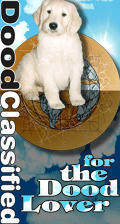
© Copyright Goldendoodles.com 2001. All rights reserved. You may not copy or otherwise use anything on this site without our written permission.
Made with Xara
.


Goldendoodles.com
Goldendoodles & Labradoodles
Dogs and people have been living together for over 14,000 years. The
reasons people have kept dogs have changed over the millennia. The earliest
domestic dogs may have alerted their masters to intruders, cleaned up
debris, and helped to hunt.
The dogs proving to be the most useful were kept and after generations
the early breeds began to define themselves. Water dogs were useful to
fishermen and shore dwellers. Hunting dogs helped to flush out and retrieve.
Some breeds have been lost to time, their functions outlived or bettered by
other breeds.
Today many breeds continue to perform the function they were intended to. Others are bred to the
same standard as working dogs but are kept as companions.
As more and more people live in the city, needs have changed. Most are not looking for dogs who can
hunt, we are looking for companions. We look for dogs who are playful, friendly towards people and
pets, easy to train and easy to maintain.
Goldendoodles
The Goldendoodle gets its name from its mixed heritage - golden retriever and poodle. Goldendoodles are a hybrid dog, a first generation cross, and as such they exhibit "hybrid vigour". the term used to describe the burst of fertility, good health and growth that is seen in the progeny when two unrelated breeds are mated. The first generation cross is healthier and grows better than either parent line. With each successive generation (F2, F3, etc.) vigour is lost. Goldendoodles were first deliberately bred in North America as a larger version of the popular Cockapoo around the mid 1990s. Their non/light shedding coats and ability to live with families with allergies has made them very popular companions.and Labradoodles
Labradoodles were first bred by the Australian Guide Dog Association in 1989 as an allergy friendly seeing eye dog. Labradoodles are still bred by the AGDA as demand requires it. Their popularity as healthy family pets spilled into North America during the late 1990s. Dr. Kate Schoeffel in NSW, Australia was the first to breed miniature Labradoodles in the early 90's, and still breeds them to this day. The AKC has ranked dogs according to popularity in North America. The Labrador Retriever heads the list at first place, with Golden Retriever ranked 4th and the Poodle ranked 5th out of 148 breeds. In his book "The Intelligence of Dogs" Stanley Coren ranks 79 dog breeds in order of intelligence. Poodles scored 2nd, Golden Retrievers were 4th and Labrador Retreiver ranked 7th. The hybrid cross between these parent breeds are terrific family dogs, friendly, intelligent, affectionate and easy to train. Many poodle crosses inherit the fur qualities of the poodle, but not the texture. This means that most don't shed, or shed lightly, and may not produce an allergic reaction. There is a table in which Labradoodle and Goldendoodle owners have stated the coat types and shedding qualities of their dogs. Click here to see the table.Sizes
The size of the Dood depends on its parentage. Breeders often offer a range including Standard, Medium and Miniature. A general rule of thumb is to add both the parents weights together and divide by 2 to get an average adult weight on the puppies. Within any litter there may be puppies that fall above or below the projected adult weights. Some Standard sized have grown to over 100 pounds. Standard - a Dood that is predicted to be 45 lbs or more at adulthood. Medium - predicted to be 30-45 lbs at adulthood. Miniature - predicted to be 15-30 lbs at adulthood.Fur Types
The Goldendoodle can inherit fur which looks retriever-like, or poodle-like, but usually something in-between.Breeders
Owner recommended Goldendoodle breeders, Labradoodle breeders and Australian Labradoodle breeders are listed on this website. These breeders all come highly recommended by the owners of their dogs - the pups are healthy, and the breeders maintain a great relationship with the owners of their dogs. Each breeder tests their breeding dogs for genetic diseases, most notably their hips,and they stand by their dogs by providing great two year health warranties. These are our Breeders' Criteria. It is important that breeders test for genetic diseases in their breeding dogs. "Cooperation between dog breeders, researchers, prospective purchasers, and purebred dog organizations at all levels is essential if genetically healthy dogs are to become a reality."¹ To learn more, read the article - Eliminating Genetic Diseases in Dogs: A Buyer's Perspective If you're considering getting a Dood - please take the time to read up on the recommendations offered by our Dood owners on how to be a Responsible Dog Owner, and Choosing a Breeder. If you have a great Goldendoodle breeder, Labradoodle breeder or Australian Labradoodle breeder you'd like to recommend - let us know! This website is a place for Doodle owners; Goldendoodle owners, Labradoodle owners, Australian Labradoodle owners and Aussiedoodle owners, to share their dogs and stories. Goldendoodle puppies, Labradoodle puppies, Australian Labradoodle puppies & Aussiedoodle puppies - we welcome them all! See pictures, photos and videos on their Doodles & Owners pages! Enjoy our site - We love our Doods!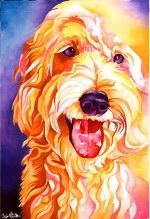
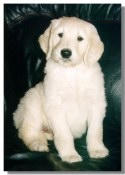
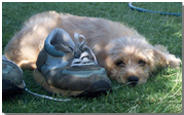
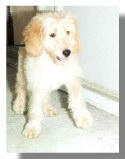
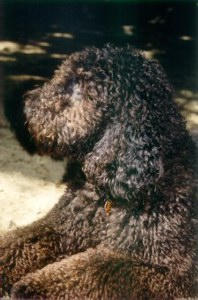
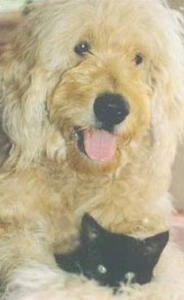
Shadow
a curly Dood
Harley
a wavy Dood
Welcome to the Goldendoodle and Labradoodle Owner's Website where we share resources,
pictures and stories about the two hybrids we've come to love
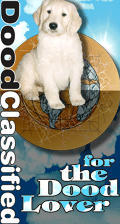
The information contained on this site is in no way intended to replace that of proper veterinary advice, diagnosis or treatment.
It is meant to provide resource, so that we can better understand canine health related issues.

© Copyright Goldendoodles.com 2001. All rights reserved. You may not
copy or otherwise use anything on this site without our written permission
Made with Xara
.
Goldendoodles & Labradoodles
Dogs and people have been living together for over 14,000 years. The reasons people have kept dogs have changed over the millennia. The earliest domestic dogs may have alerted their masters to intruders, cleaned up debris, and helped to hunt. The dogs proving to be the most useful were kept and after generations the early breeds began to define themselves. Water dogs were useful to fishermen and shore dwellers. Hunting dogs helped to flush out and retrieve. Some breeds have been lost to time, their functions outlived or bettered by other breeds. Today many breeds continue to perform the function they were intended to. Others are bred to the same standard as working dogs but are kept as companions. As more and more people live in the city, needs have changed. Most are not looking for dogs who can hunt, we are looking for companions. We look for dogs who are playful, friendly towards people and pets, easy to train and easy to maintain.Goldendoodles
The Goldendoodle gets its name from its mixed heritage - golden retriever and poodle. Goldendoodles are a hybrid dog, a first generation cross, and as such they exhibit "hybrid vigour". the term used to describe the burst of fertility, good health and growth that is seen in the progeny when two unrelated breeds are mated. The first generation cross is healthier and grows better than either parent line. With each successive generation (F2, F3, etc.) vigour is lost. Goldendoodles were first deliberately bred in North America as a larger version of the popular Cockapoo around the mid 1990s. Their non/light shedding coats and ability to live with families with allergies has made them very popular companions.and Labradoodles
Labradoodles were first bred by the Australian Guide Dog Association in 1989 as an allergy friendly seeing eye dog. Labradoodles are still bred by the AGDA as demand requires it. Their popularity as healthy family pets spilled into North America during the late 1990s. Dr. Kate Schoeffel in NSW, Australia was the first to breed miniature Labradoodles in the early 90's, and still breeds them to this day. The AKC has ranked dogs according to popularity in North America. The Labrador Retriever heads the list at first place, with Golden Retriever ranked 4th and the Poodle ranked 5th out of 148 breeds. In his book "The Intelligence of Dogs" Stanley Coren ranks 79 dog breeds in order of intelligence. Poodles scored 2nd, Golden Retrievers were 4th and Labrador Retreiver ranked 7th. The hybrid cross between these parent breeds are terrific family dogs, friendly, intelligent, affectionate and easy to train. Many poodle crosses inherit the fur qualities of the poodle, but not the texture. This means that most don't shed, or shed lightly, and may not produce an allergic reaction. There is a table in which Labradoodle and Goldendoodle owners have stated the coat types and shedding qualities of their dogs. Click here to see the table.Sizes
The size of the Dood depends on its parentage. Breeders often offer a range including Standard, Medium and Miniature. A general rule of thumb is to add both the parents weights together and divide by 2 to get an average adult weight on the puppies. Within any litter there may be puppies that fall above or below the projected adult weights. Some Standard sized have grown to over 100 pounds. Standard - a Dood that is predicted to be 45 lbs or more at adulthood. Medium - predicted to be 30-45 lbs at adulthood. Miniature - predicted to be 15-30 lbs at adulthood.Fur Types
The Goldendoodle can inherit fur which looks retriever-like, or poodle-like, but usually something in-between.Breeders
Owner recommended Goldendoodle breeders, Labradoodle breeders and Australian Labradoodle breeders are listed on this website. These breeders all come highly recommended by the owners of their dogs - the pups are healthy, and the breeders maintain a great relationship with the owners of their dogs. Each breeder tests their breeding dogs for genetic diseases, most notably their hips,and they stand by their dogs by providing great two year health warranties. These are our Breeders' Criteria. It is important that breeders test for genetic diseases in their breeding dogs. "Cooperation between dog breeders, researchers, prospective purchasers, and purebred dog organizations at all levels is essential if genetically healthy dogs are to become a reality."¹ To learn more, read the article - Eliminating Genetic Diseases in Dogs: A Buyer's Perspective If you're considering getting a Dood - please take the time to read up on the recommendations offered by our Dood owners on how to be a Responsible Dog Owner, and Choosing a Breeder. If you have a great Goldendoodle breeder, Labradoodle breeder or Australian Labradoodle breeder you'd like to recommend - let us know! This website is a place for Doodle owners; Goldendoodle owners, Labradoodle owners, Australian Labradoodle owners and Aussiedoodle owners, to share their dogs and stories. Goldendoodle puppies, Labradoodle puppies, Australian Labradoodle puppies & Aussiedoodle puppies - we welcome them all! See pictures, photos and videos on their Doodles & Owners pages! Enjoy our site - We love our Doods!




Welcome to the Goldendoodle and Labradoodle Owner's
Website where we share resources, pictures and stories
about the two hybrids we've come to love
The information contained on this site is in no way intended to
replace that of proper veterinary advice, diagnosis or treatment.
It is meant to provide resource, so that we can better understand
canine health related issues.
